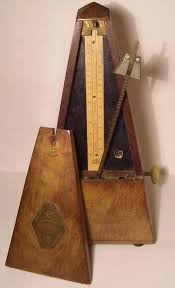
My recommendation last week of John Eliot Gardiner’s complete recording of Beethoven’s symphonies elicited a series of really wonderful comments. When, in the course of responding to those comments I rather offhandedly recommended that Otto Klemperer’s recordings of Beethoven’s symphonies (made circa 1961 for EMI) be allowed to fade into obscurity (or a shredding machine), I was soundly and eloquently thrashed.
Underlying the conversations around my recommendation was the issue of tempo: that is, the speed at which Beethoven’s symphonies (or any music, for that matter) should be performed. For performers, tempo is not just one issue among many; it is THE ISSUE: that performance parameter that must be determined before any other.
Thus, I’m dedicating this week’s post to this issue of tempo and metronome marks, which, since 1816 (or so) have been a way for composers to indicate – exactly – how fast (or slow) a piece of music should be performed.
If this conversation strikes some of you as being totally geeky, you are totally correct.
Patron Frederic Patenaude writes:
“I have a question about the tempo used by Gardiner in Beethoven’s 5th. Are you aware of the debate stirred up by Wim Winters, pianist, regarding the tempo interpretation in pieces where Chopin, Beethoven and others left metronome markings? Video Examples: How Fast did Mozart and Beethoven Really Play?, Schumann’s “incomprehensible lack” of tempo judgement, Beethoven Symphony No. 5, in Beethoven’s tempo – In light of this, it seems that the tempo chosen by Gardiner for Beethoven’s [fifth] is absurdly fast and possibly not historically correct. But even without taking this into consideration, I still find that his chosen tempo is just way too fast. However, his tempo for the 3rd seems correct. What do you think?”
What do I think? Read what I think on Patreon
